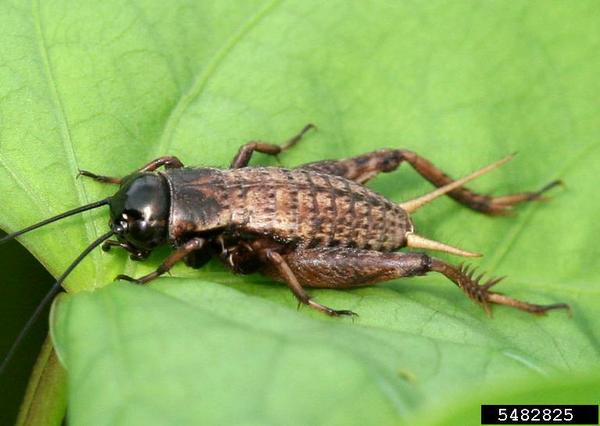Biology
Field crickets (Gryllus spp.) are occasional pests of young strawberry plants. At least five species of field crickets live in North Carolina, all of which look similar, but they differ in their habitat preferences, mating songs, and time of year in which they lay their eggs.
Young crickets, called nymphs, look like miniature, wingless versions of the adults they will grow into. Although adults have wings, they use them primarily for communication rather than for flying. In the evening, the males can be heard rubbing their wings together to attract females.
Damage
In North Carolina, crickets primarily damage the leaves of young strawberry plants after transplant. Their feeding holes are rough-edged and irregular in shape, and feeding damage occurs primarily at night. Severe enough damage to impact yield is uncommon. As such, treatment thresholds for crickets have not been established. Crickets may also occasionally feed on strawberry fruit, but this damage is typically observed in off-season high tunnel production rather than in spring fruiting, field-grown fruit.
Management Options
Cultural
As field crickets feed on the foliage and seeds of a variety of weeds, good mowing and weed control practices help to reduce their numbers. Tillage also reduces cricket populations by destroying their eggs in the soil.
Conventional Insecticides
Both foliar insecticides and baits are available for use against crickets in strawberries. Refer to the North Carolina Agricultural Chemicals Manual for materials recommended for use against crickets in North Carolina and the Southern Region Small Fruit Consortium Strawberry IPM Guide for regional recommendations.
More Information
North Carolina Agricultural Chemicals Manual
Strawberry IPM Guide – Southern Region Small Fruit Consortium
Publication date: March 19, 2014
N.C. Cooperative Extension prohibits discrimination and harassment regardless of age, color, disability, family and marital status, gender identity, national origin, political beliefs, race, religion, sex (including pregnancy), sexual orientation and veteran status.

